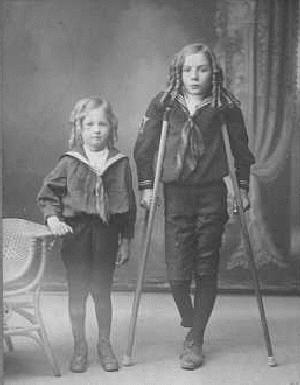
Figure 1.--This handicapped older brother is dressesd just like his younger brother, complete with a sailor suit and emaculately done ringlets. This portrait appaers to have been taken in the kate 1890s or early 1900s in America.

It was not just boys from more affluent families that were likely to have ringlet curls. Another group of boys were those that were specially cared for by their mothers. Some of the boys were coddled childrn that were raised and schooled at home and their mothers did their best to prevent them from coming in contact with all but a select range of other children to avoid any rough influnces. Some of these boys came from naotable families and information on their personal experiences are available. These could be mothers who were raising their sons alone or had husbands who considered the children to be his wives demain--at least until the boys had reached a certain age and this this age varied from family to family. This outlook in he 19th and even early 20th centuries was reflected in clothing stores. Younger boys clothes was often sold in shops for ladies vclothing while older boys clothing was sold by gentlemen's outfitters. Specialized children's clothing shops were rare. This group might also include handicapped boys who at the time were schooled at home rather than being mainstreamed. Not only did they need special care, but school authorities and the other children at the time were often not very supportive.
It was not just boys from more affluent families that were likely to have ringlet curls. Another group of boys were those that were specially cared for by their mothers. Some of the boys were coddled childrn that were raised and schooled at home and their mothers did their best to prevent them from coming in contact with all but a select range of other children to avoid any rough influnces. These could be mothers who were raising their sons alone or had husbands who considered the children to be his wives demain--at least until the boys had reached a certain age and this this age varied from family to family. This outlook in he 19th and even early 20th centuries was reflected in clothing stores. Younger boys clothes was often sold in shops for ladies vclothing while older boys clothing was sold by gentlemen's outfitters. Specialized children's clothing shops were rare.
Boys given special care might also include handicapped boys who at the time were schooled at home rather than being mainstreamed. Not only did they need special care, but school authorities and the other children at the time were often not very supportive. Thus HBC suspects if the family was finacially able, that these children were carefully cared for at home. One might suspect that mothers were especially solicitious toward these children and that many were coddleed even more that other children might have been.
Some of the boys given this special attention are known to HBC and archived in the personal acconts sections. Not all of the boys came from wealthy families and were schooled at home, but most were. Curls made a strong impression on the boys who wore them, especially as older boys. Many as adults commented on them in their memoirs. Other information is available in the correspondence of the day or in some cases from avilable portrairts, even though actual cooments by the uindividual are not availanle. Many of the personal accounts we have are American or English. This may reflect the greater popularity of ringlet curls for
boys in those countries. It may, however, just reflect HBC's greater familiarity with American and English sources. This question requires further investigation.
Information is available on individual boys from several different countries.
Navigate the Boys' Historical Clothing Web Site:
[Introduction]
[Activities]
[Bibliographies]
[Biographies]
[Chronology]
[Clothing styles]
[Countries]
[Contributions]
[FAQs]
[Glossaries]
[Boys' Clothing Home]
